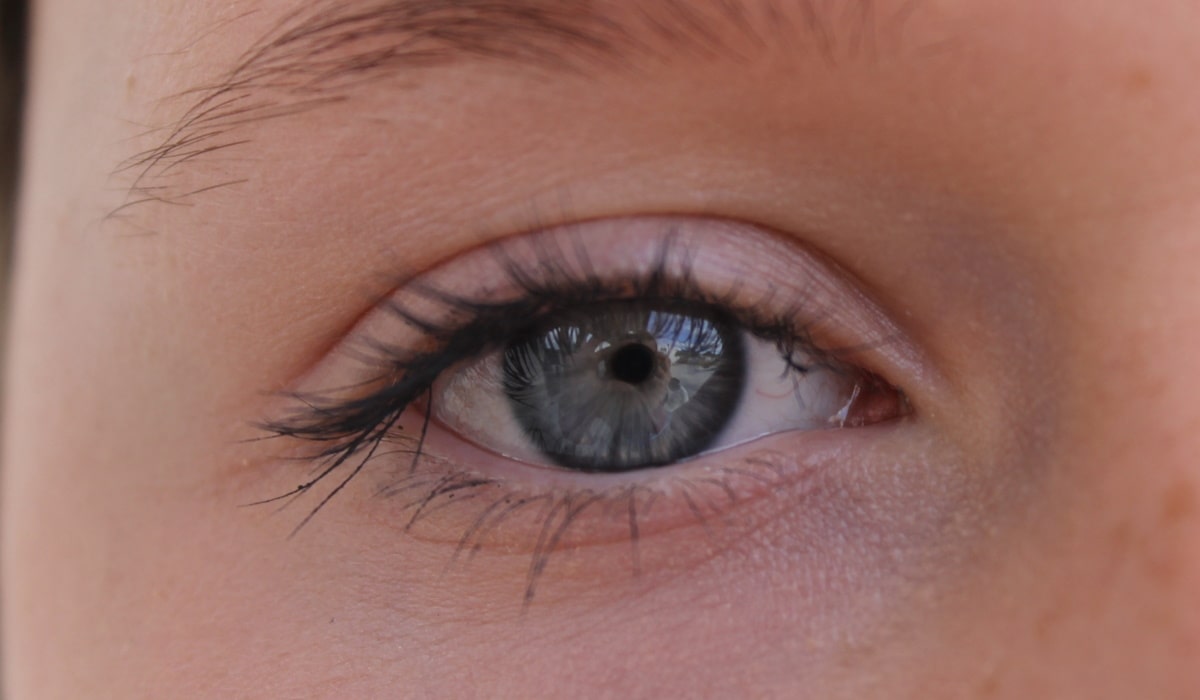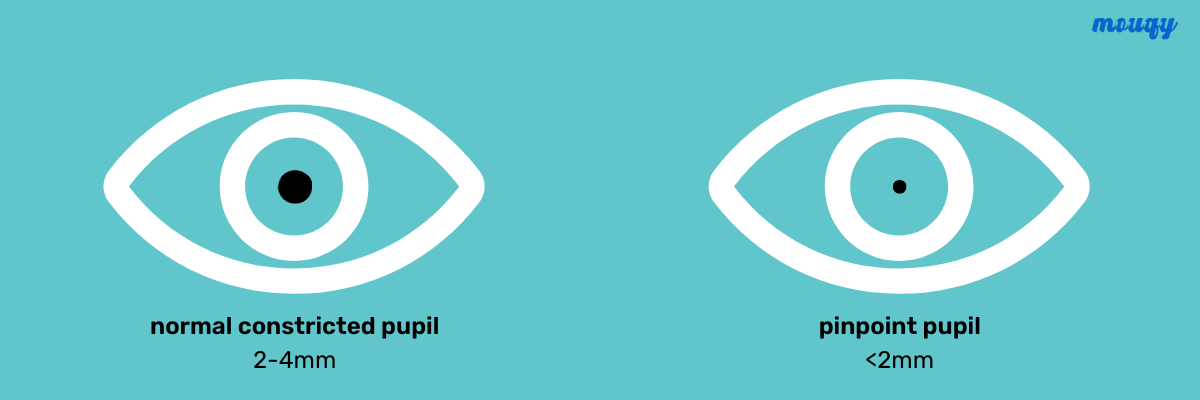Pinpoint Pupils: Why Are My Pupils Small?
They say that eyes are the windows to your soul – easily conveying how you feel or what’s on your mind. But eyes are also a good indicator of our overall health.
In this article, we’re looking at one of the most overlooked symptoms of underlying health conditions: pinpoint pupils.
More than what meets the eye, right?
What are pinpoint pupils?
Pinpoint pupils (AKA small pupils) are exactly what they sound like: pupils that appear abnormally small (or below 2 mm) in normal lighting conditions. This is medically known as miosis or myosis, which comes from the Greek word ‘muein’ or ‘to close the eyes’.
How do our pupils normally change size?
As you may already know, our pupils are intrinsically designed to change in size depending on our surroundings. This is our body’s natural way of regulating the light that enters our eyes throughout the day. It’s not something that you can consciously control or feel, though you might notice changes in your vision.
For instance, when exposed to direct sunlight or any bright light, the pupils constrict (or shrink) to restrict the amount of light that enters. On the other hand, the pupils dilate (or get larger) at night time or under low lighting to help us see better in the dark.
To give you a better picture, an adult pupil should measure 2 – 4 mm under bright light, and approximately 4 – 8 mm in low light.
How much the pupil constricts or dilates in response to light will also vary as you age, as studies have shown that pupil size is largest at adolescence, but gradually shrinks throughout adulthood.
Besides lighting and the natural aging process, there are also other factors that affect pupil size, such as the distance of the object that we’re focusing on. When looking at nearby objects, our pupils involuntary shrink, while zeroing in on a faraway object causes our pupils to dilate.
Lastly, pupils may also shift in size depending on your emotional state. For example, when triggered by something that scares or excites you, your pupils get bigger. Whereas in a relaxed state, they shrink back to their natural size.
What are the causes of pinpoint pupils?
So, what happens when your pupils are smaller than usual, or stay small even under dim light? Then it may be the result of one of the conditions below.
1. Medication and drug usage
Oftentimes, prescription drugs for pain relief, such as opioids, can cause pinpoint pupils. The same can also be said for substance abuse such as an overdose of heroin, barbiturates, tobacco, and other drugs.
Treatments that require miotic drugs like pilocarpine, which is used to treat glaucoma and dry mouth, can also cause miosis, as well as medications for hypertension, particularly clonidine and tetrahydrozoline.
2. Stroke, injury and trauma
Any damage on the eye or brain can cause pinpoint pupils on one or both eyes, which could be a sign of internal problems. That being said, it’s important to seek medical attention for any type of head injury as you may not notice side effects from the get-go.
3. Inflammation of the iris
Iritis, or irritation and swelling of the iris, is another condition that can also lead to abnormally small pupils. These can be caused by infectious diseases, as well as lung, skin, gastrointestinal and rheumatic conditions.
4. Poisoning from toxic chemicals
You can also develop pinpoint pupils from exposure to herbicides, pesticides, and other poisons containing organophosphates. Any type of poisoning can be deadly, so definitely seek treatment as soon as possible to counter the effects before it’s too late.
5. Horner syndrome
Also known as Horner-Bernard syndrome or oculosympathetic palsy, Horner syndrome is caused by a problem in the nerve pathway that connects your brainstem to your eyes and face. This condition can be congenital but also caused by trauma or stroke, and usually affects one side of the face.
6. Cluster headaches
Much like their name, cluster headaches come in groups and last for around 30 to 45 minutes, and can happen as frequently as 8 times a day. Other characteristics include severe pain behind or around one eye, but this can sometimes spread to other areas of the face, head and neck.
What are the symptoms of pinpoint pupils?
Since pinpoint pupils are also a symptom and not a condition, investigating on accompanying symptoms can help you figure out the root cause of the problem.
Overdose in opioids and other drugs can produce symptoms like a pale or clammy face, difficulty breathing, nausea or vomiting, purple or blue fingernails, as well as a slow heartbeat.
Symptoms related to injuries, trauma and stroke include vision problems such as diplopia or double vision, as well as dizziness, balance problems, and slurred speech.
As for inflammation of the iris, it’s common to experience light sensitivity, blurry vision and eye pain along with pinpoint pupils.
Exposure to harmful chemicals can cause breathing difficulties, coughing, rapid pulse, vomiting, and excessive saliva, though some side effects may also be cognitive (e.g. decreased memory, loss of motor function, etc.) so it might be hard to catch. Luckily, your eyes can be a good sign that you may need to seek treatment.
Lastly, those with Horner syndrome may have miosis in one eye, as well as a drooping eyelid, and an inability to sweat on the affected side of the face. Cluster headaches can sometimes produce similar symptoms, particularly drooping eyelids on the same side as the headaches.
What are the treatments for pinpoint pupils?
Even though you aren’t experiencing any other symptoms besides pinpoint pupils, it is crucial to see your doctor immediately so they can perform a proper diagnosis. This can prevent more alarming symptoms from appearing, any permanent damage, and other life-threatening complications.
If your current medications are what’s causing your pinpoint pupils, then your doctor will most likely prescribe you with alternative treatments. But if it’s due to substance abuse, then your doctor can help you come up with a strategic plan to safely overcome drug dependence or addiction.
For Horner syndrome, inflammation of the iris, as well as injuries, treatment would depend from case to case. Some may require surgery (especially if a tumor is found), while others can be treated with eye drops and other medicines prescribed by your doctor.
As for pinpoint pupils due to poisoning, treatments would also vary depending on the type of poisoning and the amount of exposure. Some doctors may prescribe antidotes, sedatives, and anti-seizure medications, but if lung function is impaired, then patients would need help from a ventilator while recovering.
Remember – always check up on your eyes
And there you have it! We hope that this blog was able to give you more insight on pinpoint pupils and the importance of keeping tabs on your health—especially your eyes.
For more expert advice, do check out our blog for more health topics, including our best tips on how to find the right glasses prescription for your specific visual needs.

Written by:
Allysa Gatchalian












